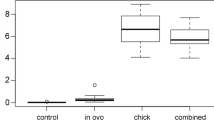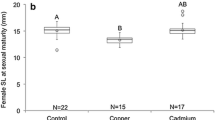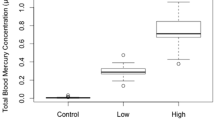Abstract
Recently it was shown that female fish injected with enriched stable isotopes maternally transmit a chemical signature to larval otoliths. Validation of this larval marking technique requires laboratory experiments to determine appropriate injection concentrations and to assess any negative effects on larval and adult condition. This study investigated the temporal profile of 137barium assimilation and retention in tissues of adult female anemonefish Amphiprion melanopus (Pomacentridae) following intraperitoneal injection with either 2 or 4 μg 137Ba g−1 body mass. Mean barium isotope ratios (138Ba:137Ba) in the two groups of treated fish were not significantly different from each other, but were significantly different from those in the control group up to 56 days post-injection. This pattern of 137Ba retention was consistent across gonad, muscle, liver and bone tissues. Mean plasma cortisol concentration (an indicator of non-specific physiological stress) was not significantly different among groups and was considered to be representative of unstressed fish. Together, these results indicate that (1) A. melanopus suffer minimal physiological stress and cope well after treatment with 137Ba, (2) 137Ba is retained in female A. melanopus for a prolonged period (at least 56 days), such that multiple clutches of offspring are likely to be marked with an isotopic signature, and (3) a lower dosage of 2 μg 137Ba g−1 appears sufficient for transgenerational marking. It is concluded that 137Ba is suitable for use as a transgenerational marker and is a powerful tool to resolve long-standing enigmas such as larval dispersal distances and the fishery benefits of marine reserves.


Similar content being viewed by others
References
Almany GR, Berumen ML, Thorrold SR, Planes S, Jones GP (2007) Local replenishment of coral reef fish populations in a marine reserve. Science 316:742–744
Almany GR, Connolly SR, Heath DD, Hogan JD, Jones GP, McCook LJ, Mills M, Pressey RL, Williamson DH (2009) Connectivity, biodiversity conservation and the design of marine reserve networks for coral reefs. Coral Reefs 28:339–351
Arai T, Hirata T (2006) Determination of trace elements in otoliths of chum salmon Oncorhynchus keta by laser ablation-ICP-mass spectrometry. Fish Sci 72:977–984
Barton BA (2002) Stress in fishes: a diversity of responses with particular reference to changes in circulating corticosteroids. Integr Comp Biol 42:517–525
Begg K, Pankhurst NW (2004) Endocrine and metabolic responses to stress in a laboratory population of the tropical damselfish Acanthochromis polyacanthus. J Fish Biol 64:133–145
Bellwood DR, Hughes TP, Folke C, Nystrom M (2004) Confronting the coral reef crisis. Nature 249:827–833
Botsford LW, White JW, Coffroth MA, Paris CB, Planes S, Shearer TL, Thorrold SR, Jones GP (2009) Connectivity and resilience of coral reef metapopulations in marine protected areas: matching predictive efforts to predictive needs. Coral Reefs 28:327–337
Campbell CM, Pottinger TG, Sumpter JP (1992) Stress reduces the quality of gametes produced by rainbow trout. Biol Reprod 47:1140–1150
Cowen RK, Paris CB, Srinivasan A (2006) Scaling of connectivity in marine populations. Science 311:522–527
Dietz DD, Elwell MR, Davis WE, Meirhenry EF (1992) Subchronic toxicity of barium-chloride dihydrate administered to rats and mice in the drinking-water. Fundam Appl Toxicol 19:527–537
Fautin DG, Allen GR (1992) Field guide to anemonefishes and their host sea anemones. Western Australian Museum, Perth
Foster S, Choudhury H, Colman J, Ingerman L, Robbins P (1998) Toxicological review of barium and compounds. Environmental Protection Agency, Washington DC
Frisch AJ, Anderson TA (2000) The response of coral trout (Plectropomus leopardus) to capture, handling and transport and shallow water stress. Fish Physiol Biochem 23:23–34
Frisch A, Anderson T (2005) Physiological stress responses of two species of coral trout (Plectropomus leopardus and Plectropomus maculatus). Comp Biochem Physiol 140A:317–327
Frisch AJ, McCormick MI, Pankhurst NW (2007a) Reproductive periodicity and steroid hormone profiles in the sex-changing coral-reef fish, Plectropomus leopardus. Coral Reefs 26:189–187
Frisch AJ, Walker SPW, McCormick MI, Solomon-Lane TK (2007b) Regulation of protogynous sex-change by competition between corticosteroids and androgens: an experimental test using sandperch, Parapercis cylindrica. Horm Behav 52:540–545
Gagliano M, McCormick MI (2009) Hormonally mediated maternal effects shape offspring survival potential in stressful environments. Oecologia 160:657–665
Gell FR, Roberts CM (2003) Benefits beyond boundaries: the fishery effects of marine reserves. Trends Ecol Evol 18:448–455
Godwin JR, Thomas P (1993) Sex-change and steroid profiles in the protandrous anemonefish Amphiprion-Melanopus (Pomacentridae, Teleostei). Gen Comp Endocrinol 91:144–157
Hellberg ME, Burton RS, Neigel JE, Palumbi SR (2002) Genetic assessment of connectivity among marine populations. Bull Mar Sci 70:273–290
Jones GP, Milicich MJ, Emslie MJ, Lunow C (1999) Self-recruitment in a coral reef fish population. Nature 402:802–803
Jones GP, Almany GR, Russ GR, Sale PF, Steneck RS, van Oppen MJH, Willis BL (2009) Larval retention and connectivity among populations of corals and reef fishes: history, advances and challenges. Coral Reefs 28:307–325
Knowlton N, Jackson JBC (2008) Shifting baselines, local impacts, and global change on coral reefs. PLoS One 6:215–220
Leis JM, McCormick MI (2002) The biology, behaviour and ecology of the pelagic, larval stage of coral reef fishes. In: Sale PF (ed) Coral reef fishes: dynamics and diversity in a complex ecosystem. Academic, San Diego, pp 171–191
McCook LJ, Ayling T, Cappo M, Choat JH, Evans RD, De Freitas DM, Heupel M, Hughes TP, Jones GP, Mapstone B, Marsh H, Mills M, Molloy FJ, Pitcher CR, Pressey RL, Russ GR, Sutton S, Sweatman H, Tobin R, Wachenfeld DR, Williamson DH (2010) Adaptive management of the Great Barrier Reef: a globally significant demonstration of the benefits of networks of marine reserves. Proc Nat Acad Sci 107:18278–18285
Mora C, Sale PF (2002) Are populations of coral reef fish open or closed? Trends Ecol Evol 17:422–428
Munro AR, Gillanders BM, Thurstan S, Crook DA, Sanger AC (2009) Transgenerational marking of freshwater fishes with enriched stable isotopes: a tool for fisheries management and research. J Fish Biol 75:668–684
Newton K, Cote IM, Pilling GM, Jennings S, Dulvy NK (2007) Current and future sustainability of island coral reef fisheries. Curr Biol 17:655–658
Pankhurst NW (2011) The endocrinology of stress in fish: an environmental perspective. Gen Comp Endocrinol 170:265–275
Pickering AD, Pottinger TG (1989) Stress responses and disease resistance in salmonid fish: effects of chronic elevation of plasma cortisol. Fish Physiol Biochem 7:253–258
Sale PF, Cowen RK, Danilowicz BS, Jones GP, Kritzer JP, Lindeman KC, Planes S, Polunin NVC, Russ GR, Sadovy YJ, Steneck RS (2005) Critical science gaps impede use of no-take fishery reserves. Trends Ecol Evol 20:74–80
Schreck CB (2010) Stress and fish reproduction: the roles of allostasis and hormesis. Gen Comp Endocrinol 165:549–556
Schreck CB, Lorz HW (1978) Stress response of coho salmon (Oncorhynchus kisutch) elicited by cadmium and copper and potential use of cortisol as an indicator of stress. J Fish Res Bd Can 35:1124–1129
Thorrold SR, Jones GP, Planes S, Hare JA (2006) Transgenerational marking of embryonic otoliths in marine fishes using barium stable isotopes. Can J Fish Aquat Sci 63:1193–1197
Thorrold SR, Zacherl DC, Levin LA (2007) Population connectivity and larval dispersal: using geochemical signatures in calcified structures. Oceanography 20:80–89
Wilkerson JD (2003) Clownfishes: a guide to their captive care, breeding and natural history. Microcosm, Charlotte, U.S.A.
Williamson DH, Jones GP, Thorrold SR, Frisch AJ (2009) Transgenerational marking of marine fish larvae: stable-isotope retention, physiological effects and health issues. J Fish Biol 74:891–905
Zar JH (1999) Biostatistical Analysis. Prentice-Hall, London
Acknowledgments
Funding for this work was provided by the Australian Research Council Centre of Excellence for Coral Reef Studies. The authors are grateful for logistical support provided by S. Weaver, G. Duffin and J. Morrison at the Marine and Aquaculture Research Facilities Unit, Yi Hu at the Advanced Analytical Centre, and N. Pankhurst at the Fish Endocrinology Laboratory, James Cook University. Technical assistance from D. Lemke and K. Markey was also greatly appreciated. This research was undertaken with permission from the James Cook University Animal Ethics Review Committee (approval no. A1134).
Author information
Authors and Affiliations
Corresponding author
Rights and permissions
About this article
Cite this article
Roy, AS., Frisch, A.J., Syms, C. et al. Retention of a transgenerational marker (137Barium) in tissues of adult female anemonefish and assessment of physiological stress. Environ Biol Fish 96, 459–466 (2013). https://doi.org/10.1007/s10641-012-0029-y
Received:
Accepted:
Published:
Issue Date:
DOI: https://doi.org/10.1007/s10641-012-0029-y




